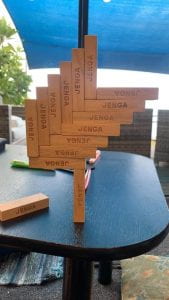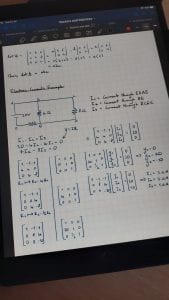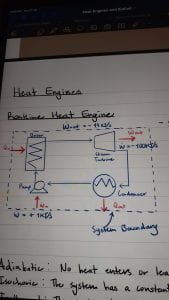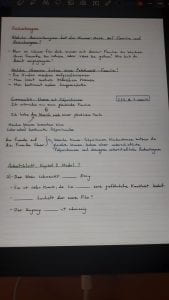As some of you may know (from my rather concise bio), I study engineering, and it has been a running joke on my floor that us engineering students are simply “applied scientists”. This has gotten on my nerves, since it has made me feel a bit self conscious about engineering and has made me question whether it is even the right fit for me. But after much deliberation, I have made peace with the statement “applied scientist”, after realising that I do indeed love engineering, and that it is so much more than just the application of science. So what better way to introduce engineering than to go through each of the courses I studied last semester?
ENGGEN121 – Engineering Mechanics
121 is by far the hardest engineering course in first semester, but it actually ended up being one of my favourites! The first half of the semester is about statics (i.e. things that aren’t moving), and is taught by Jason. While the concepts are familiar from high school, the applications definitely are not! Some of the interesting topics we learned were trusses, pulleys, centroids and friction. As I mentioned previously, this course is difficult, but statics was a walk in the park in comparison to dynamics (i.e. things that move), which is taught by Hazim. To start off with, dynamics seemed to reflect more of the typical mechanics we had learned in high school, but as we moved into unknown topics such as relative motion, rigid bodies and (more) pulleys, things started to get intense. In saying that, those ‘difficult’ topics ended up being some my favourite ones. Oh, and one final thing – GET GOOD AT DRAWING FREE BODY DIAGRAMS (FBD’s). You will be drawing literally hundreds of them, and they will help you get on Hazim’s good side form the basis for the whole entire course, so you need to be good at them!
ENGSCI111 – Mathematical Modelling 1 (MM1)
This is the first course in a series of three maths courses (MM2 and MM3 are taken in the second and third years), because maths pretty much underpins all of engineering, so it’s vital all engineering students, regardless of specialisation, can handle it. The great thing about this course is it actually teaches you about the applications of the maths you learn, unlike a lot of the random high school knowledge that leaves you thinking “when am I actually gonna use this??”. The first part of the course pretty much reiterates calculus knowledge from year 13 as well as a few new ways to integrate things, before going head-first into new topics such as ODE’s, statistical modelling, vectors and matrices. The three lecturers for this course all bring something different to the teaching ‘experience’. Richard does Kahoots halfway through each lecture, John tells terrible dad jokes (because he’s a dad) and Peter does things with juggling and unicycling, although we unfortunately missed out because of the lockdown (although he does teach part of ENGGEN131 this semester, so fingers crossed!) Basically, my only advice for this course is to revise the calculus you learn in high school, since it only gets harder from there.
ENGGEN140 – Energy and Society
Do you know how solar panels work? Or how a steam engine converts heat into electricity? Well I certainly didn’t until I took this course. 140 is nothing like what I learned in high school, making it really interesting to learn. The course essentially outlines how energy is extracted, converted and used, while also considering the social, environmental and cultural impacts of each type of energy. The cultural and ethical aspects of the course were taught by Rosalind Archer, while the more technical aspects were taught by Andrea Kolb – both of whom are extremely approachable and will answer literally any questions you have. Overall, the course definitely helped shape my understanding of renewable energies and why they (unfortunately) aren’t actually always the best option. My favourite part of the course however, had to be learning about heat engines. To be completely honest, I never thought heat engines would be an enjoyable topic, however I was definitely proven wrong! Oh, and one more thing: SIGNIFICANT FIGURES. Never in my life have I lost so many marks due to wrong significant figures…. Don’t tell me I didn’t warn you.
GERMAN301
Ok, so I know this blog was technically supposed to be about engineering, but I am also doing a diploma in languages, so why not also be an advocate for language learning? First thing to take note, is that I’m doing a 300 level German paper. Normally if you’ve taken a language up to level 3 in high school, you start with 200 level courses, but since I got an NZQA scholarship in German, they allowed me to skip straight to 300 level. At first I thought it was going to be way too difficult for me, but it turns out it was just right! The lectures are more like tutorials or classes at high school, since the class size is so small (only 14 last semester!). We spent a lot of time simply speaking in German and discussing the relevant topics, making the two hours fly by a lot faster than one hour lectures do. The small class size also meant that we ended up doing a lot of things together, such as parties, going to Shads or just meeting up. It definitely made up for the fact that it was so hard to make friends in the engineering lectures, with up to 500 people in each one! Overall, German ended up being my favourite course, simply because I didn’t feel like I was forcing myself to learn. And if that hasn’t convinced you to start or continue language learning at uni, I don’t know what will.
Anyway, I seem to have rambled on for quite a bit now, so I’ll rap it up there. I hope this blog gave you an insight into the semester 1 engineering courses (plus GERMAN301). If you want to see more UoA course reviews, you could always check out the (totally unbiased) reviews on Student Course Review. Oh, and if you were wondering, the featured image of this blog is actually a computational model of the new Engineering building!
Tschüss!
– Callum




